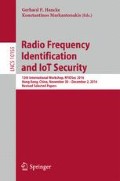Abstract
Privacy and anonymity on the Internet have become a serious concern. Even when anonymity tools like Tor or VPNs are used, the IP and therefore the approximate geolocation from which the user connects to such a service is still visible to an adversary who controls the network. Our proposal \(\upmu \)Proxyaims to mitigate this problem by providing a relay of user-controlled hardware proxies that allows to connect to a (potentially public) network over a large physical distance. One endpoint is connected to a public Wifi hotspot, while the other end connects (over a chain of relay nodes) to the user’s computer. \(\upmu \)Proxy uses a lightweight protocol to create a secure channel between two endpoint nodes, whereas the communication can be routed over an arbitrary amount of relay nodes. The employed cryptography is based on NaCl, using Curve25519 for the key exchange as well as Salsa20 and Poly1305 for authenticated payload encryption. \(\upmu \)Proxy tunnels TCP/IP connections and can therefore be used to secure and anonymize existing, unprotected protocols. We implemented \(\upmu \)Proxy on the ESP8266, a popular Wifi microcontroller, and show that \(\upmu \)Proxy incurs a latency of 20.4 ms per hop under normal operating conditions.
Access this chapter
Tax calculation will be finalised at checkout
Purchases are for personal use only
References
Bernstein, D.J., Lange, T., Schwabe, P.: The security impact of a new cryptographic library. In: Hevia, A., Neven, G. (eds.) LATINCRYPT 2012. LNCS, vol. 7533, pp. 159–176. Springer, Heidelberg (2012). doi:10.1007/978-3-642-33481-8_9
Bernstein, D.J.: Curve25519: new Diffie-Hellman speed records. In: Yung, M., Dodis, Y., Kiayias, A., Malkin, T. (eds.) PKC 2006. LNCS, vol. 3958, pp. 207–228. Springer, Heidelberg (2006). doi:10.1007/11745853_14
Bernstein, D.J., Gastel, B., Janssen, W., Lange, T., Schwabe, P., Smetsers, S.: TweetNaCl: a crypto library in 100 tweets. In: Aranha, D.F., Menezes, A. (eds.) LATINCRYPT 2014. LNCS, vol. 8895, pp. 64–83. Springer, Cham (2015). doi:10.1007/978-3-319-16295-9_4
Caudill, B., Paranoia, P.: High-stakes anonymity on the internet (2015). https://www.defcon.org/html/defcon-23/dc-23-speakers.html
Dingledine, R., Mathewson, N., Syverson, P.: Tor: the second-generation onion router. In: Proceedings of the 13th USENIX Security Symposium (SSYM 2004). USENIX Association (2004)
Espressif. Espressif smart connectivity platform: ESP8266 (2013). https://nurdspace.nl/images/e/e0/ESP8266_Specifications_English.pdf
Espressif. ESP-NOW User Guide (2016). https://espressif.com/sites/default/files/documentation/esp-now_user_guide_en.pdf
Espressif. ESP8266 Datasheet (2016). https://espressif.com/sites/default/files/documentation/0a-esp8266ex_datasheet_en.pdf
Espressif. ESP8266EX (2016). http://espressif.com/products/hardware/esp8266ex/overview/
Greenberg, A.: Online anonymity project proxyham mysteriously vanishes (2015). http://www.wired.com/2015/07/online-anonymity-project-proxyham-mysteriously-vanishes/
Hedrick, C.: Routing Information Protocol. RFC 1058, RFC Editor (1988)
Hutter, M., Schwabe, P.: \(\mu \)NaCl–the networking and cryptography library for microcontrollers (2015). http://munacl.cryptojedi.org/index.shtml
Kamkar, S.: ProxyGambit (2015). http://samy.pl/proxygambit/
Lohr, C.: How to directly program an inexpensive ESP8266 Wifi module (2015). http://hackaday.com/2015/03/18/how-to-directly-program-an-inexpensive-esp8266-wifi-module/
Moy, J.: OSPF Version 2. RFC 2178, RFC Editor (1997). https://www.rfc-editor.org/info/rfc2178
O’Sullivan, T.: Telnet Protocol: A Proposed Document. RFC 0495, RFC Editor (1971)
Author information
Authors and Affiliations
Corresponding author
Editor information
Editors and Affiliations
Rights and permissions
Copyright information
© 2017 Springer International Publishing AG
About this paper
Cite this paper
Cox, D., Oswald, D. (2017). \(\upmu \)Proxy: A Hardware Relay for Anonymous and Secure Internet Access. In: Hancke, G., Markantonakis, K. (eds) Radio Frequency Identification and IoT Security. RFIDSec 2016. Lecture Notes in Computer Science(), vol 10155. Springer, Cham. https://doi.org/10.1007/978-3-319-62024-4_13
Download citation
DOI: https://doi.org/10.1007/978-3-319-62024-4_13
Published:
Publisher Name: Springer, Cham
Print ISBN: 978-3-319-62023-7
Online ISBN: 978-3-319-62024-4
eBook Packages: Computer ScienceComputer Science (R0)

